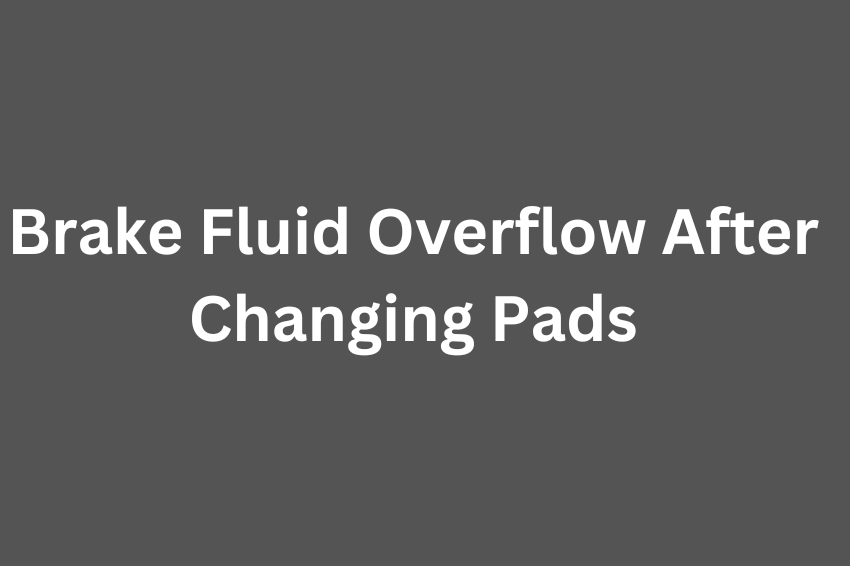Have you ever wondered why brake fluid overflows when you replace your brake pads?
It’s all about the way your car’s brakes work.
This guide breaks down the mechanics of the brake system and explains why compressing the pistons can lead to overflow.
Gain a clear understanding of this issue and how to address it for safe and effective brakes.
Is It Safe To Drive With Overflowing Brake Fluid?
Do not drive your car if your brake fluid reservoir is overflowing.
Overflowing brake fluid is a serious safety concern that can greatly impact your car’s braking performance.
Your car’s brakes rely on a hydraulic system filled with brake fluid.
When you press the brake pedal, the fluid transmits pressure to the wheels, creating friction that slows down your car.
Brake fluid is incompressible, meaning it can’t be squeezed.
When you compress the brake pistons to replace your brake pads, some of the brake fluid gets pushed back into the reservoir.
If the reservoir is already full, this excess fluid can overflow.
The problem arises because overflowing fluid can introduce air bubbles into the brake system.
Air pockets in the brake lines are compressible, unlike brake fluid.
This means when you press the brake pedal, the air compresses instead of transmitting pressure to the wheels.
This results in a spongy brake pedal that feels soft and requires you to press much harder to slow down the car.
In extreme cases, air in the brake system can lead to complete brake failure, making it impossible to stop the car.
Preventing Brake Fluid Overflow During Pad Replacement

Changing your brake pads is a great way to maintain your car’s stopping power.
But did you know that compressing the brake caliper pistons during the process can sometimes cause brake fluid to overflow from the reservoir?
Don’t worry, there are a few simple steps you can take to prevent this from happening:
1. Check the Brake Fluid Level Before You Begin:

- Pop the hood and locate the brake fluid reservoir. It’s usually a translucent plastic container with a minimum and maximum fill line marked on the side.
- Take a peek at the fluid level. If it’s already close to the “max” line, there’s a higher chance of overflow when you compress the pistons.
2. Remove a Small Amount of Fluid (Optional):
- If the fluid level is near the maximum, you can carefully extract a small amount using a turkey baster (remember, never use that baster for food again!). This will create some extra space in the reservoir to accommodate the displaced fluid.
3. Compress the Brake Caliper Piston Carefully:

Here’s where preventing overflow becomes key.
The brake caliper piston needs to be compressed to make room for the thicker new brake pads.
There are two main methods:
- C-Clamp Method (Optional): Consult your car’s manual for the specific location of the brake caliper piston on each wheel. You can purchase a C-clamp tool to slowly and evenly compress the piston back into the caliper. This method offers more control over the process and helps minimize the amount of fluid pushed back into the reservoir.
- Disc Brake Pad Spreader Tool: This tool is specifically designed to compress the brake caliper piston while spreading the existing pads apart. It’s a good option if you’re comfortable with DIY brake repairs.
4. Use a Zip Tie to Secure the Piston (Optional):
Once you’ve compressed the piston enough to fit the new pads, some users recommend using a zip tie to temporarily hold the piston in place.
This prevents it from springing back and pushing more fluid into the reservoir while you replace the pads on the other wheels.
5. Monitor the Fluid Level as You Work:
Keep an eye on the brake fluid reservoir level throughout the process.
If it gets close to the “max” line again, stop and remove a little more fluid with the baster (if you used it).
Understanding Why Brake Fluid Overflows When Changing Pads
Have you ever wondered why brake fluid might overflow when you’re replacing your brake pads?
It all has to do with how your car’s brakes work.
Imagine your brake system like a giant water balloon filled with brake fluid, a special kind of liquid that can’t be compressed.
When you press the brake pedal, this fluid gets pushed through tubes to the brake calipers at each wheel.
Inside the calipers, some pistons squeeze the brake pads against the discs, slowing down your car.
Here’s where the overflow happens:
- Normal Brake Operation: During regular braking, when you release the pedal, the pistons relax slightly, creating a tiny bit of extra space in the system. This space allows the brake fluid to flow back freely from the calipers to the reservoir, the little container that holds the brake fluid.
- Compression During Pad Change: Now, when you change your brake pads, they’re usually thicker than the old ones. To make room for the new pads, you need to compress the brake caliper pistons back a bit. This pushing action forces some of the brake fluid back up into the reservoir.
- Overflow Risk: If the reservoir is already full (because of worn-out pads, for example), this extra fluid from compressing the pistons can cause it to overflow. Think about what happens when you try to overfill a water balloon, the excess spills out!
Overflowing brake fluid can introduce air bubbles into the system, which can make your brakes feel spongy and less effective.
In extreme cases, it could even lead to brake failure.
